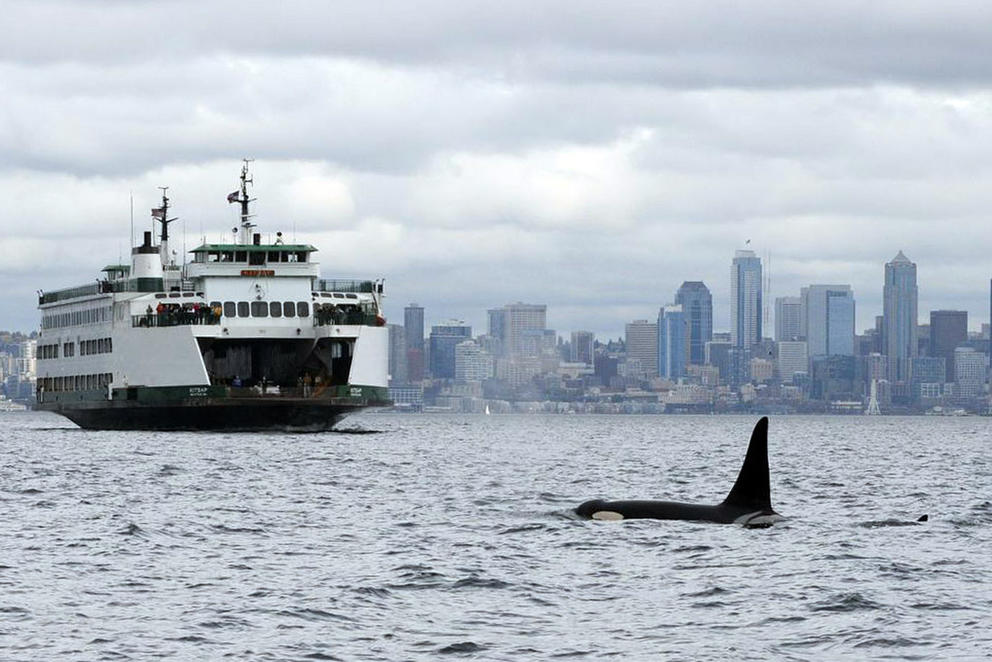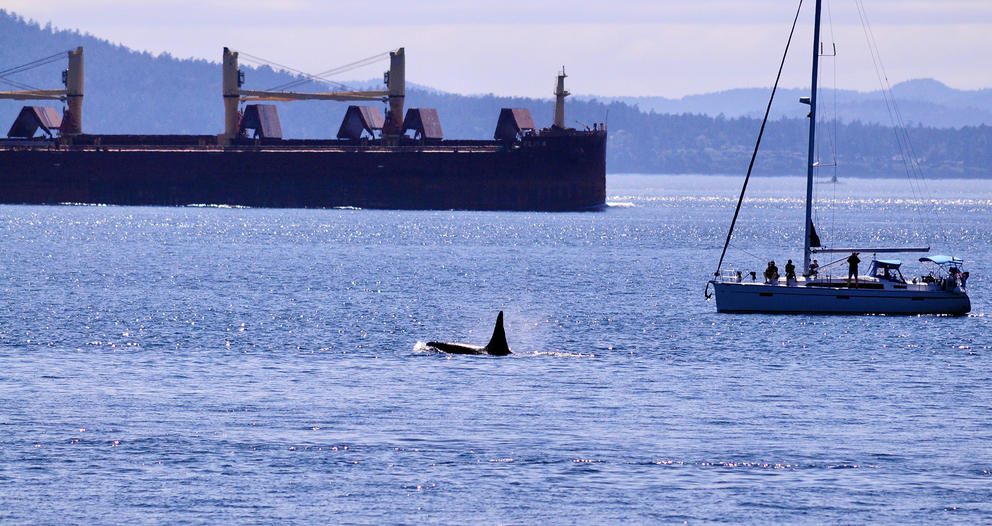“For whales, it was probably a nice sound vacation, and we can build on that into a system that is sustainable for both humans and for whales,” she said.
To protect endangered orcas in Washington state waters, a new collaborative program called Quiet Sound is preparing to launch several voluntary initiatives in the new year that are aimed at cutting underwater noise from large ships. Aronson directs Quiet Sound via the nonprofit Washington Maritime Blue, and she said the new measures range from piloting a potential seasonal slowdown zone for commercial vessels to using app-based technology to notify ship operators of nearby orca sightings in real time.
Rachel Aronson, program director of Quiet Sound, an initiative that aims to reduce the amount of ship noise pollution on local Southern Resident orcas, poses for a photograph at Fisherman's Terminal in Seattle, Washington, Monday, Dec. 13, 2021. The initiative is sponsored by Washington Maritime Blue. (Lindsey Wasson for Crosscut)
Today, Quiet Sound is just starting to come into focus. Its organizers thus far have concentrated on finding funding, hashing out the program’s direction and basic operations, and adding partners among government agencies, tribes, the maritime industry, and nonprofits. Now with more than $800,000 in funding for the next couple years, including from the state Legislature, the program hopes to turn down the volume on cargo ships, ferries, tugboats, fish processors and oil tankers in greater Puget Sound.
Quiet Sound’s origins can be traced to the Southern Resident Orca Task Force, formed in 2018 by Washington Gov. Jay Inslee. The next year, the task force released final recommendations for reversing the decline of these struggling marine mammals, and included some recommendations focused on reducing vessel noise.
Vessels, both their presence and the underwater noise they generate, are among the top threats to the recovery of the southern resident orcas who frequent Puget Sound in the summer and fall each year. These echolocating marine mammals rely on sound to navigate, find food and communicate in a relatively dark seascape.
As more ships speed through the growing region’s waters, however, the added noise drowns out the orcas’ calls, increases their stress levels and limits their ability to seek out their preferred prey, endangered chinook salmon. Even the mere presence of vessels within 400 yards can disrupt the southern residents, especially females, as they hunt for scarce fish, research led by the National Oceanic and Atmospheric Administration shows.
Like an underwater sprinter, adult orcas burn a lot of energy chasing chinook salmon, one fish at a time, and with less food to go around, adults struggle to catch enough to feed themselves, much less find the energy to reproduce and feed their hungry calves. A noisier ocean makes all of this more challenging.
That’s where Quiet Sound hopes to make a difference in the wake of the orca task force’s 2019 recommendations.
According to Jon Sloan, interim director of the Port of Seattle’s maritime environment and sustainability program, the port first had to take those recommendations and help rally a planning team that includes state, local and federal agencies, the Makah Tribe, the shipping industry and nonprofits like Maritime Blue. And then there was the fundraising. The ports of Seattle and Tacoma and their joint venture ponied up $100,000 of seed money in their 2021 budgets to get Quiet Sound started.
With those pieces finally coming together, Quiet Sound is eager to start having an impact on noise levels in Puget Sound. Aronson pointed out that slowing down large ships by just a moderate amount translates to even greater reductions in the underwater noise generated by ship propellers and engines, while having only a minimal impact on vessel travel times.
Quiet Sound is modeled on the similarly coalition-focused Enhancing Cetacean Habitat and Observation program, which Canada’s biggest port, the Port of Vancouver, started in 2014 to bring together diverse groups to cut noise pollution from large vessels coming into the bustling international port. While its early efforts concentrated on answering basic research questions about, for instance, vessel noise sources and levels, in recent years ECHO has been testing real-world measures to reduce noise impacts from large vessels traveling to and from the port, targeting times and places the southern residents are mostly likely to overlap with ship traffic, according to ECHO program manager Orla Robinson.
One measure suggests that ships slow down in specified zones in Haro Strait and Boundary Pass, which border the San Juan Islands, from June to roughly October, when the orcas tend to follow salmon into this region. Another ECHO initiative asks tugboats to shift their paths away from a critical orca feeding area along the southern coast of Vancouver Island in the Strait of Juan de Fuca, a measure that led to a 60% to 80% drop in sound intensity in 2020.
Although ECHO is a voluntary program, participation from the shipping industry remains extremely high, around 80% to 90% for ships going into and out of the Port of Vancouver. And Robinson said the program also can point to measurable drops in vessel noise, thanks to a network of underwater microphones, or hydrophones. Independent research funded by the ECHO program suggests that such efforts to quiet the waters of places like Haro Strait could pay off, increasing the likelihood that the southern residents will return to hunt there.
ECHO’s results in British Columbia show promise that the Quiet Sound program could also help address existing vessel traffic noise in Washington waters, said Lovel Pratt, marine protection and policy director at nonprofit Friends of the San Juans.
“Hopefully, the Quiet Sound program will have similar success in terms of participation from the shippers and documented reductions in noise,” she said. Pratt added, however, that such programs aren’t perfect solutions, given the major projected increases in ship traffic in the Salish Sea, in part due to proposals to build or expand fossil fuel projects and shipping terminals.
Aronson, who has been in the job only a few months, is also encouraged by the early successes of ECHO, as well as the Canadian program’s support for Quiet Sound’s own burgeoning efforts.
While the new program is still trying to bring additional partners on board, Quiet Sound plans to make its public debut in January. That’s also when the organization’s leaders are set to begin convening working groups to pursue a pilot slowdown area in Washington waters, among other initiatives.
“The dream is: know where the whales are concentrating their activity and where that overlaps with high ship activity; [and then] put the slowdown recommendation into place [when] seasonally appropriate,” said Aronson.
Quiet Sound also plans to tap into ECHO’s WhaleReport Alert System, a two-way platform run by the Canadian conservation nonprofit Ocean Wise to flag real-time orca sightings for mariners and port personnel.
The idea is that ships can then curb their speeds, post an additional whale spotter or move away from marine mammals in the area if it’s safe to do so. On top of reducing noise pollution, such measures could also lead to fewer ships striking whales. Washington State Ferries, a major source of underwater noise, have already started using the WhaleReport Alert System after a ship collided with and killed an orca in 2016.
However, the alert system has several limitations, which Quiet Sound acknowledges. For example, it currently can receive whale sighting observations only through the Whale Report app and makes them available only to a private group of users. This setup leaves out an existing array of robust sources that report where orcas have been in Washington waters — data currently available to the public, who are often the ones generating it.
In addition, the alert system has relatively little data on whale sightings south of the Canadian border, something that Aronson and Quiet Sound hope to remedy in the days ahead.
“We'd like to work with some of our friends out there who have good whale data and help them connect their whale data to the WhaleReport Alert System,” said Aronson.
Critics say Quiet Sound has plenty of potential allies in the Pacific Northwest’s long-established whale observation community, but maintains that the program’s early rollout has already managed to alienate some of them.
Quiet Sound will have to overcome certain tensions within the passionate community of people who have long been working on many of these issues in Washington, according to Fred Felleman, a whale biologist and environmental consultant with expertise in commercial shipping safety. Felleman also happens to be the Port of Seattle’s commission president and a board member of Maritime Blue, but is not speaking in either capacity here.
“While I’m very supportive of the program’s goals, I do have some serious concerns about its current implementation,” Felleman wrote via email.
As a close observer not permitted to participate directly in rolling out Quiet Sound, Felleman said his concerns began as the not-yet-formed organization was assembling its early partners and developing its direction.
In Felleman’s personal opinion, early planners have neglected the well-established orca-sighting and scientific communities — the type of people with “experience on the water with the whales.” That includes the whale-watching industry, which has its own industry-specific reporting app for sightings, and groups like the nonprofit Orca Network, which has been running a community science network of whale observers in Washington on a shoestring budget for 20 years.
“That's the part I just think is an unforced error. And it creates alienation amongst the very folks that should be your closest friend,” said Felleman.
Susan Berta, co-founder and executive director of Orca Network, confirmed via email that her group feels left in the dark when it comes to Quiet Sound and its goals, though she saw promise for working together under the right conditions. Berta worries that the program’s focus on the WhaleReport Alert System and its own app in particular could potentially undermine the region’s existing whale reporting infrastructure, like that supported by her own scrappy nonprofit.
For years, Orca Network has been compiling the public’s whale sightings in Puget Sound via a hotline, email, and social media (and is supporting the imminent local expansion of a U.S.-based app). That data is, in turn, used by researchers and natural resource managers, said Berta, and the group does all of this with very little financial support. For instance, the nonprofit receives $15,000 a year from the federal government to turn its orca observations into an annual report.
If the public started funneling its local orca sightings instead to WhaleReport Alert System via the Whale Report app, Berta fears such competition might divert their members away from Orca Network and “result in loss of data for us, researchers and state and federal agencies who rely on it.”
“We have been asking and hoping for some support of the local [Washington]-based networks who have worked hard to build up our whale sightings and hydrophone networks over the last two decades,” she wrote of Quiet Sound, “but so far there are meetings and more meetings, then silence with no communication while they continue communicating with, working with, and funding Canadian efforts, which is disheartening for us.”
Aronson is aware of such concerns and hopes Quiet Sound can find an acceptable way to link other sources of data like Orca Network’s into the WhaleReport Alert System and connect real-time whale sightings directly to mariners, who right now don’t have easy access to them as they steer ships through Washington waters.
“One challenge is just finding the space that we can move things forward without re-creating the work that someone else has already done,” she said.
And while she acknowledges that Quiet Sound may have been a “black box” so far, Aronson is excited to open up the organization with many more opportunities for public engagement and outreach starting in January.
That sentiment is shared by the Port of Seattle’s Sloan, who also points to January when Quiet Sound will start reaching out to organizations the group has “unofficially slated” to participate in working groups that would kick off the program’s various initiatives. He said, “I know there's some anxiety out there. 'Well, how come we haven't been invited into Quiet Sound yet?' Well, the working groups haven't been formed yet. So that's when that will happen.”
CORRECTION: This story has been corrected from an earlier version to show that an orca died after colliding with a ship not a ferry.






